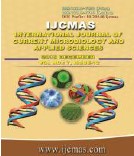


 National Academy of Agricultural Sciences (NAAS)
National Academy of Agricultural Sciences (NAAS)

|
PRINT ISSN : 2319-7692
Online ISSN : 2319-7706 Issues : 12 per year Publisher : Excellent Publishers Email : editorijcmas@gmail.com / submit@ijcmas.com Editor-in-chief: Dr.M.Prakash Index Copernicus ICV 2018: 95.39 NAAS RATING 2020: 5.38 |
Cyanobacteria are photosynthetic microorganisms capable of producing high value pigments like phycoerythrin, phycocyanin, allophycocyanin, chlorophyll and carotenoids. These high value pigments have immense commercial value as they have applications in food, pharmaceutical and cosmetic industries. In the present study, using soil and water samples collected from different ecological niches of India, 10 isolates of heterocystous and 09 isolates of non- heterocystous cyanobacteria were obtained. Morphological identification revealed that the isolates belonged to Nostoc, Anabaena, Phormidium, Lyngbya, Westiellopsis, Aphanotheca, Oscillatoria, Tolypothrix and Chroococcus. When these isolates were screened for phycoerythrin, Nostoc sp. BG1 was recorded with highest (870 µg/mL) production. Determination of phycocyanin revealed Nostoc sp. RD1 to be the highest (450 µg/mL) producer. Westiellopsis sp. BG2 was found to produce maximum (530 µg/mL) of Allophycocyanin. Likewise, Phormidium sp. SB6 was recorded as highest Chlorophyll a (270 µg/mL) producer. In case of carotenoids, Lyngbya sp. SB2 showed maximum (13 µg/mL) production. These isolates can be potential candidates for high value pigment production and could be exploited for commercial use in future.
 |
 |
 |
 |
 |